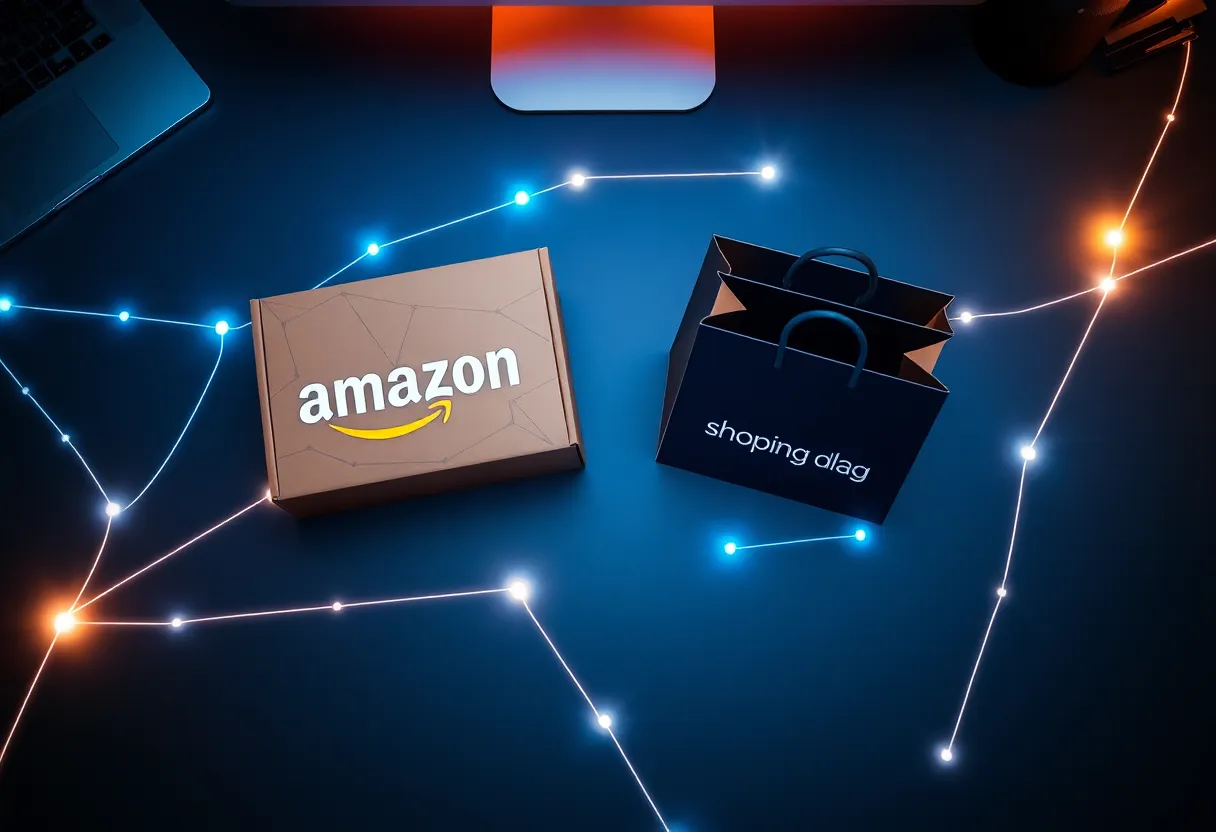Table of Contents
The Amazon-Shopify Integration Landscape
Did you know that 45% of online shoppers start their product searches on Amazon? This massive customer base makes Amazon a goldmine for e-commerce businesses. But managing multiple sales channels can be a real headache for sellers.
Enter the world of multi-channel selling. More and more businesses are expanding beyond a single platform to reach wider audiences. This trend has sparked a boom in tools that connect different marketplaces, with Amazon-Shopify integration being a top priority for many sellers.
Why Sellers Are Going Multi-Channel
- Increased visibility
- Diversified revenue streams
- Access to new customer segments
- Reduced dependence on a single platform
However, juggling multiple platforms isn’t without its challenges. Sellers often struggle with:
- Keeping inventory synced across channels
- Managing orders from different sources
- Maintaining consistent pricing
- Tracking performance across platforms
This is where integration tools come in handy. They act as a bridge between Amazon and Shopify, automating many of these tedious tasks.
| Feature | Manual Management | With Integration Tool |
|---|---|---|
| Inventory Updates | Hours daily | Real-time sync |
| Order Processing | 30+ mins per order | Automatic |
| Pricing Changes | Manual updates | Instant across channels |
Want to see how easy it can be to connect Shopify with Amazon? Check out this helpful video guide:
As the e-commerce landscape evolves, tools like Marketplace Connect are making it easier than ever for businesses to expand their reach across multiple platforms. By streamlining the connection between Amazon and Shopify, sellers can focus on growing their business instead of getting bogged down in technical details.
Setting Up Your Amazon-Shopify Connection
Connecting Amazon to Shopify can seem daunting, but it’s actually pretty straightforward. The key is choosing the right integration app. You want something that’s reliable, easy to use, and won’t break the bank.
Once you’ve picked your app, it’s time to set things up. Here’s a quick rundown:
- Install the app from the Shopify App Store
- Link your Amazon account by following the prompts
- Map your product categories so everything lines up nicely
It might take a bit of time to get everything sorted, but trust me, it’s worth it. A good integration app will walk you through each step, making the process a breeze.
This video gives a great overview of how to set up your Amazon-Shopify integration. It covers some key points we’ve discussed and offers visual guidance for those who prefer to see the process in action.
Syncing Inventory and Orders
Once you’re all set up, keeping your inventory in sync is crucial. Nobody wants to sell something they don’t have in stock. That’s where real-time updates come in handy.
Here’s how a good sync process should work:
- You make a sale on Amazon
- Your Shopify inventory updates automatically
- The order details pop up in your Shopify dashboard
- You fulfill the order from one central place
Sounds simple, right? That’s because it is – when you have the right tools. Our Marketplace Connect app does all this and more, keeping everything running smoothly behind the scenes.
But what about when things go wrong? Sometimes stock levels can get mixed up. Here’s how to handle it:
- Regularly check your inventory levels across both platforms
- Set up low stock alerts to catch issues early
- Have a plan for quickly resolving discrepancies
By staying on top of these things, you’ll avoid headaches down the road.
Optimizing Pricing and Listings
Now, let’s talk about making your products shine on both Amazon and Shopify. It’s not just about having your items listed – it’s about making them stand out.
First up, pricing. You want to be competitive, but you also need to make a profit. Here’s a simple strategy:
| Platform | Pricing Strategy |
|---|---|
| Amazon | Match or beat competitors slightly |
| Shopify | Offer exclusive bundles or discounts |
This approach lets you stay competitive on Amazon while giving customers a reason to buy directly from your Shopify store.
When it comes to product listings, each platform has its quirks. On Amazon, you’ll want to focus on:
- Keyword-rich titles
- Bullet points highlighting key features
- High-quality images from multiple angles
For Shopify, you have more freedom. Use this to your advantage by:
- Telling your brand’s story
- Showcasing lifestyle images
- Offering more detailed product descriptions
By tailoring your approach to each platform, you’ll maximize your visibility and sales potential. And remember, a tool like Marketplace Connect can help keep everything in sync, so you’re not constantly juggling multiple listings.
At the end of the day, connecting Amazon to Shopify is about making your life easier and your business more efficient. With the right setup and tools, you can focus on growing your business instead of getting bogged down in the details. If you’re looking to streamline your multi-channel selling, check out our Marketplace Connect app. It might be just what you need to take your e-commerce game to the next level.
Measuring Success and Overcoming Challenges
Connecting Amazon to Shopify can supercharge your e-commerce business, but success doesn’t happen automatically. Smart sellers track key metrics and tackle integration hurdles head-on. Let’s break down how to measure your progress and overcome common roadblocks.
Key Performance Indicators to Watch
Keeping an eye on the right numbers helps you gauge the impact of your Amazon-Shopify integration:
- Total sales across both platforms
- Order fulfillment speed
- Inventory accuracy
- Customer satisfaction ratings
- Return rates
These metrics paint a clear picture of how well your multi-channel strategy is working. Tools like Marketplace Connect can help aggregate this data, making it easier to spot trends and make informed decisions.
Troubleshooting Integration Hiccups
Even the smoothest setups can hit snags. Here are some common issues and quick fixes:
- Sync delays: Check your internet connection and update frequency settings
- Inventory discrepancies: Manually reconcile stock levels and adjust buffer quantities
- Order processing errors: Double-check shipping rules and tax settings
Remember, most integration tools offer support channels. Don’t hesitate to reach out if you’re stuck – that’s what they’re there for!
Scaling Your Multi-Channel Business
As your sales grow, so do the challenges. Here’s how to keep up:
- Automate wherever possible (order routing, inventory updates, etc.)
- Invest in robust inventory management software
- Consider outsourcing fulfillment to handle increased volume
- Regularly review and optimize your product listings on both platforms
Scaling successfully means working smarter, not harder. That’s where tools like Marketplace Connect shine, automating tedious tasks so you can focus on growth strategies.
By keeping a close eye on your KPIs, quickly addressing integration issues, and planning for scale, you’ll be well-equipped to make the most of your Amazon-Shopify connection. Remember, the goal is to create a seamless experience for both you and your customers across all sales channels.
Wrap-up Taking Your E-commerce to the Next Level
Connecting Amazon to Shopify can really boost your online business. It lets you sell in more places without all the extra work. You can keep track of orders and inventory across both platforms easily. This means less stress for you and happier customers.
If you’re thinking about trying this out, start small. Pick a few products to list on Amazon through your Shopify store. See how it goes. You might be surprised at how much easier it makes things. Our Marketplace Connect tool can help with this process, syncing everything automatically.
As online shopping keeps growing, having your products on multiple sites will become even more important. Shopify and Amazon working together smoothly is just the beginning. Who knows what other cool integrations we’ll see in the future?
Ready to learn more? Check out our Shopify app for details on how to get started. And if you have questions, don’t worry. We’ve got answers coming up next.
Common Questions About Amazon-Shopify Integration
How much does it cost to connect Amazon and Shopify?
The cost varies depending on the integration method you choose. Native Shopify apps like Marketplace Connect start at $19.99 per month, with a free trial available. This allows you to test the functionality before committing. Keep in mind that Amazon may have separate fees for professional seller accounts.
What technical skills do I need to integrate Amazon with Shopify?
You don’t need advanced technical skills to connect Amazon and Shopify. Most integration apps, including Marketplace Connect, offer user-friendly interfaces. Basic familiarity with your Shopify admin panel and Amazon Seller Central is helpful, but the process is designed to be straightforward for most users.
Can I sync inventory between Amazon and Shopify?
Yes, inventory syncing is a key feature of Amazon-Shopify integrations. Tools like Marketplace Connect provide real-time inventory updates across both platforms. This helps prevent overselling and keeps your stock levels accurate across all sales channels.
How are orders from Amazon handled in Shopify?
Integration apps typically import Amazon orders into your Shopify dashboard. This allows you to manage all orders in one place. With Marketplace Connect, for example, you get unified order management, meaning you can process Amazon orders alongside your Shopify orders seamlessly.
What support is available if I have issues with the integration?
Most integration apps offer customer support to help with setup and ongoing issues. Look for apps with good ratings and reviews that mention responsive support. Marketplace Connect, for instance, has a 4.7 rating and is known for its helpful customer service team who can assist with any integration challenges.
Can I use Amazon FBA with my Shopify store?
Yes, many Amazon-Shopify integrations support Fulfillment by Amazon (FBA) for Shopify orders. This allows you to leverage Amazon’s fulfillment network for orders placed on your Shopify store. It’s a great way to streamline your operations and potentially reduce shipping costs.





